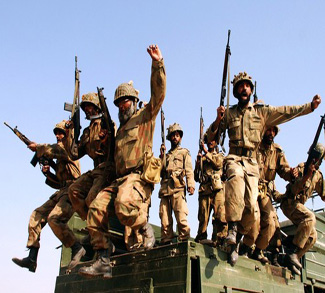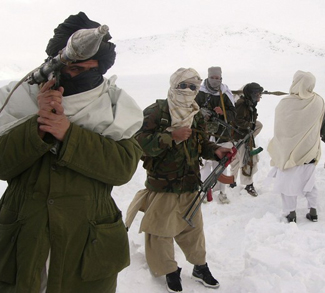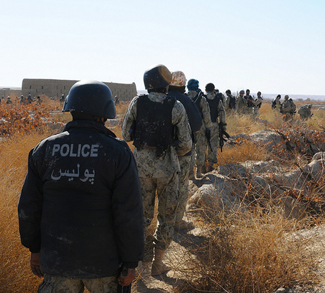FORECAST
It’s a dizzying time for anyone trying to keep track of militant groups in Pakistan. Over the past two years, ever smaller groups keep appearing; as they do, they focus on more specific kinds of attacks.
Some of the new groups, like the “Azam Brigade,” specialize in attacks on convoys of trucks carrying supplies for NATO from Pakistan to Afghanistan. Others, like the “Asian Tigers,” specialize in kidnappings. Still others, like “Al-Qittal” – the Arabic word for “Fight” (Against Infidels) – focus on targeted killings.
The plethora of new groups is not only a change from the previous tendency among Pakistani militant groups to form large umbrella organizations like the Tehrik-e Taliban Pakistan (TTP). It also has been accompanied by a breakdown of these larger structures, making it uncertain what kind of command structure the new groups share.
“Over the last two years, splinter groups have been emerging with different new names, like al-Mukhtar, Punjabi Taliban, and Badar Mansoor, and there are a dozen other names,” journalist Zia ur-Rehman, who specializes in militant groups, tells Radio Mashaal. “Whenever there is raid by the Criminal Investigation Department, a new group is discovered. Basically these are the splinter groups of [once larger organizations like the] TTP, or Lashkar Jangvi, or other jihadist groups.”
He lists the new splinter groups as: Badar Mansoor, Al-Furqan, Al-Mukhtar, Al-Kharooj, Al-Azam Brigade, Asian Tigers, Jand-ul-hafsa, Lashkar-e-Baluchistan, Punjabi Mujahedin, Jandullah, Itihad-e-Mujahideen Khurasan, and Al-Qital.
Security pressure
One reason for the splintering of militant groups may be increased pressure from security forces. During the past two years, a US drone killed TTP head Baitullah Mehsud (2009) and Navy SEALs killed Al-Qaeda head Osama Bin Laden (2011). Pakistani security operations also have taken their toll, particularly in Karachi, where many militant groups hide out.
But whether the splintering should be viewed as a victory for the security forces is difficult to say. As the militants downsize, they also become harder to catch.
“In large groupings they can be spotted easily, so for security reasons they move like ordinary people because it is difficult to trace them,” Mazhar Mashwani, a top official of Pakistan’s Criminal Investigation Department, says.
The rise in small groups corresponds to a rise in the number of terrorist attacks across Pakistan. Two years ago, 70 percent of the attacks were confined to Pakistan’s tribal areas or Khyber-Pakhtunkhwa Province. Today, attacks have become commonplace across Pakistan, with at least half as many people killed in 2010 elsewhere in Pakistan as in the tribal areas.
Another reason militant groups are splintering may be due to financial pressure. In recent years, counter-terrorism strategies have made it harder for supporters to transfer large sums from abroad. That, in turn, has made it harder for larger organizations to stay afloat.
Brigadier Mahmoud Shah, a defense analyst and ex-security chief for Pakistan’s tribal areas, notes that smaller groups can better cover their own expenses.
“Tehrik-e Taliban Pakistan is now very weak, and now there are small groups emerging that were part of it in the past,” Shah says. “Until now, the TTP was working under Al-Qaeda and it was giving them money. They were also collecting some donations from Gulf countries as well. But now the [Pakistani] government and foreign countries have imposed so many sanctions that their ways of income are so reduced that they are raising funds through kidnapping for ransom.”
Mixed signals
Still, if downsizing helps solve some of the militants’ safety and financial problems, it risks creating others. Previously, the groups were tied into the complex hierarchies and decision-making processes of umbrella organizations. Now they have the ease and simplicity of acting on their own, but their independence could make it harder to coordinate their actions and maintain a united front.
Today the groups still appear to be working together, but their cooperation can look shaky. When the splinter group Al-Mukhtar carried out a suicide bombing against the home of a top security official in Karachi in September, it immediately claimed responsibility. But within hours, Tehrik-e Taliban Pakistan silenced the group and took over the media campaign for the attack by claiming responsibility for it.
How long the militant movement can retain cohesion under such conditions is unclear. With more groups entering the field, discipline within any movement can become harder to maintain. That not only risks turning jihad into a free-for-all; it also opens the doors wider to criminal gangs ready to pose as jihadists while terrorizing for profit. If the jihadi movement cannot expel them, the criminals’ presence could hurt the movement’s recruitment abilities.
Yet another risk is of power rivalries developing between the splinter groups in the future. That is not yet the case, as the groups seem to avoid competition by specializing in different kinds of activities. But there is a decades-long history of rivalries among Pakistani militant groups and open conflict is not uncommon.
In the North Waziristan tribal agency last month, for example, a hitherto unknown alliance of new splinter groups calling itself the Itihad-e Mujahedin Khurasan (IMK) declared the preexisting militant power in the area as its enemy. The IMK charged the North Waziristan Shura, which is led by Gul Bahadur and supported by the Haqqani group, with being “agents of the Pakistan army” and said it would not let them or anyone else stand in its way.
For those who want peace in Pakistan, the chance that the splintering of the jihad movement could bring less coordination and more internal feuding offers hope for the future. But for now, such divisions appear to be conscious tactical moves as much as any response to security forces’ successes.



